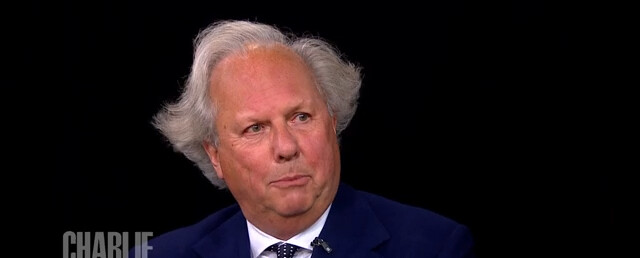Has anyone ever pointed out the parallel between Howard Stern and Graydon Carter? Because when I read the latter’s just-published memoirs, When the Going Was Good: An Editor’s Adventures during the Last Golden Age of Magazines, the similarity jumped right out at me. Stern became the King of All Media by mocking the famous, then turned on a dime and began praising and hobnobbing with them; Carter made his name as editor of the weekly magazine Spy (1986-98), in which he sneered mercilessly at big shots, then graduated to the monthly Vanity Fair, where for 25 years (1992-2017) he cozied up to — and celebrated — celebrities.
Born and raised in Ottawa, Carter had what reads like a deadly dull Canadian childhood in a rather flush and self-impressed family. His parents belonged to a “slightly down-at-heel sailing club”; his uncle “lived on D’Oyly Carte Island, a family property on the Thames”; his aunt “was a vice president of the Canadian National Railway.” In his student years, Carter founded and edited the Canadian Review. But as soon as possible he hied to New York to work at Time.
It was a great time to be at Time, but not such a great time to be in New York. “New York in the summer of 1978,” Carter writes, “was a festering pot of arson, stabbings, prostitution, and graffiti, all of it chronicled in trademark hysterics by the New York Post.” Well, if it really was “a festering pot,” etc., what was so hysterical about reporting honestly on it? This is an early taste of Carter’s snobbery — snobbery toward the supposed lowbrow Post and its readers, most of whom tended, then as now, to be the kind of people who, living in dangerous parts of New York and taking the subway to work, actually have a reason to worry about street crime.
Did I say snobbery? Carter’s the kind of guy who, arriving in the Big Apple without a sou — or a suit — buys one not at Macy’s but at Paul Stuart on Madison Avenue. He learns quickly where to eat dinner (Elaine’s, Lutèce) if you want to be part of the “in” crowd. And like many newcomers, he learns — this is obligatory — to look down on the outer boroughs.
In 1985, after five years at Time and two years at Life, Carter co-created Spy, which made fun of everything from literary logrolling to the “gray and cheerless” house style of the New York Times. And, especially, of celebrities. One celebrity who was a favorite target was none other than Donald Trump, whom Spy incessantly labeled a “short-fingered vulgarian.” Carter even profiled Trump for GQ, portraying him, in Carter’s own words, “as an outer-borough sharpie with taste that veered toward the showy and the vulgar.”
After gaining notoriety with Spy, Carter worked briefly at New York Observer, then took the helm at VF. It soon became clear that, as with Stern, all his ridiculing of celebrities at Spy had been rooted in envy. In fact, he’d already started collecting illustrious pals, among them Mike Nichols, Diane Sawyer, and Nora Ephron — “the greats of New York,” he calls them without irony — even during his days as a faceless drone at Time. One of his longest-lasting New York chums is Fran Lebowitz, who’s probably devoted even more time than Carter has to amassing famous friends.
But for Carter, Lebowitz, Ephron, and company were only the start. After less than a year at VF, he boasts, he’d made it onto Jann Wenner’s birthday-party list, along with “Calvin and Kelly Klein, Billy Joel, Malcolm Forbes, Ahmet and Mica Ertegun, Andy Warhol, Fred Hughes, Lorne Michaels, David Geffen, Paul Simon.” On the West Coast, he became best buddies with the former superagent Sue Mengers, a “star snob” who “wanted only above-the-line talent at her table” and whose parties were crowded with “the single-name stars: Warren, Jack, Barbra, Elton, Ali, Anjelica, Marlon, Francis, Candice, Bette, and Jennifer (Lopez and Aniston).”
It all sounds horrible. But Carter was entranced.
I don’t know when I’ve ever encountered so much shameless name-dropping. He’s so good at it that he can even drop one name-drop within another name-drop: he met one famous couple, he tells us, “in Paris at a summer dinner at Karl Lagerfeld’s vast hôtel particulier during the couture shows.” And speaking of Paris, he wants us to know that when he wasn’t in New York, he “stayed at the Connaught in London, the Ritz in Paris, the Hotel du Cap in the South of France, and the Beverly Hills Hotel or the Bel-Air in Los Angeles. Suites, room service, drivers in each city. For European trips, I flew the Concorde.” Oh, and his passport picture? Taken by — who else? — Annie Leibovitz.
Soon enough, Carter traded in his wife, the mother of his children, for a newer model. And this one was perfect for him: the daughter of one of Queen Elizabeth’s private secretaries, she’d spent her teen years in “a grace-and-favor apartment in St. James’s Palace.” Together, she and Carter made all the right moves. They lived at the Dakota and later in the Village. They also had a house in Connecticut. (“Money was always scarce,” he writes with a straight face, even though he was pulling down perhaps the second largest editorial salary in the world — Anna Wintour, nine floors up at 300 Madison Avenue, was first.)
I’d expected Carter’s book to focus on the day-to-day business of magazine production. There’s a bit of that sort of thing here, and unless you’re titillated by lists of famous names, it’s the most interesting stuff in the book. At Time, we learn, stories would be written from Wednesday through Friday, then “distributed throughout the building” via “Lamson pneumatic tubes.” Teams of editors “chiseled the copy into rigorous, data-filled, adjective-heavy Time-es,” then handed off to meticulous fact-checkers. (Well, I think it’s interesting.) And VF? Carter’s first move was to “change the voice.” During the reign of his predecessor, Tina Brown, “a restaurant wasn’t a restaurant, it was a ‘boîte.’ A book wasn’t a book, it was a ‘tome.’ A party wasn’t a party, it was a ‘fete.’” Carter banned those words, along with abode, opine, plethora, glitzy, wannabe, A-list, coiffed, eatery, flick, scribe, Tinseltown, and many others.
Speaking of the actual work of editing, it’s surprising that Carter, in his own book, makes elementary grammatical errors, including “badly” for “bad” (“I felt badly”) and dangling modifiers (“Growing up in Canada, movies were a window into the world of adult drama, comedy, and sophistication”). Which brings me to this question: why on earth does a man who was one of the world’s highest-paid editors need a co-author? On the title page of When the Going Was Good, it reads: “Graydon Carter with James Fox.” Which one is responsible for all the grammatical howlers — Graydon or James?
Then again, one thing that this book makes clear is that for Carter, reading, writing, and editing aren’t anywhere near as appealing as planning, throwing, and attending parties. It was he, after all, who invented the VF Oscar party in 1994. By year two, he brags, “people were skipping the official Oscar party and coming to ours.” He lets us know that “anybody with an Academy Award” got in at once. “Because that was the job that night: to get as many of those Oscar winners as possible into our room.”
One illuminating factoid: plenty of Carter’s cherished — and outrageously overpaid — A-list guests also turned out to be petty thieves. “In the ladies’ room we had decanter-sized bottles of cologne from companies like Dior and Chanel. By the end of the evening, they’d all be gone.” Once he caught Adrien Brody “trying to smuggle out one of our electrified candle lamps on the tables …. He’s a gentleman, and a charming one at that, and still apologizes any time I see him.” So now I know what Carter means by “gentleman”: a thief with an Oscar.
As if the Oscar party wasn’t enough, VF also began buying a few tables at the annual White House Correspondents’ Association dinner, although it pulled out after Trump became president — a detail that affords Carter another opportunity to bash our president: “Trump lived the way a poor person in a folktale might have imagined how a rich person lived — high up in gilded faux Regency and Louis XIV surroundings.” Plus, he’s an “autocrat,” a “tyrant,” a “narcissist in a class of his own.” This from a man whose life revolves around vapid egomaniacs like “Jack” and “Bette” — and who recounts at tiresome length his dinner with (woo-hoo!) Princess Margaret.
As mentioned, I opened When It Was Good hoping for an engaging account of magazine editing — a subject close to my heart. By the end of the book, Graydon Carter had come fully into focus for me as an extraordinarily silly person whose most rewarding hours have been spent cultivating, promoting, and slobbering over other silly people who happen to be famous. He’s less an editor than he is a socialite, a bon vivant, a party planner, a man who seems never to have spent two seconds contemplating the meaninglessness and ephemerality of fame.
And above all, he’s an insufferable snob. In 2001, the British writer Toby Young wrote a book about his brief, disastrous stint at VF. The main reason for his failure, Young eventually realized, was that he’d gone into the job entirely misreading his boss: he’d thought that the Carter who edited Spy was the real Carter, and that the fatuous celebrity-worship was an act. Boy, did he have it backwards. “Two kinds of people read Vanity Fair,” Carter told Toby Young once. “Trailer park white trash and everyone who matters.”
That line may or may not fairly describe VF’s readership. But it sure captures the appalling mentality of Grayson Carter, who in these pages has done a splendid job — in collaboration with James Fox — of portraying himself as a silly, superficial snob for the ages.
READ MORE from Bruce Bawer:





![Trump's Admin Guts Another ‘Rogue Government Agency with Zero Accountability’ [WATCH]](https://www.right2024.com/wp-content/uploads/2025/03/Trumps-Admin-Guts-Another-‘Rogue-Government-Agency-with-Zero-Accountability-350x250.jpg)



![‘We All Owe Him (Elon) a Huge Debt of Gratitude’ [WATCH]](https://www.right2024.com/wp-content/uploads/2025/03/‘We-All-Owe-Him-Elon-a-Huge-Debt-of-Gratitude-350x250.jpg)







